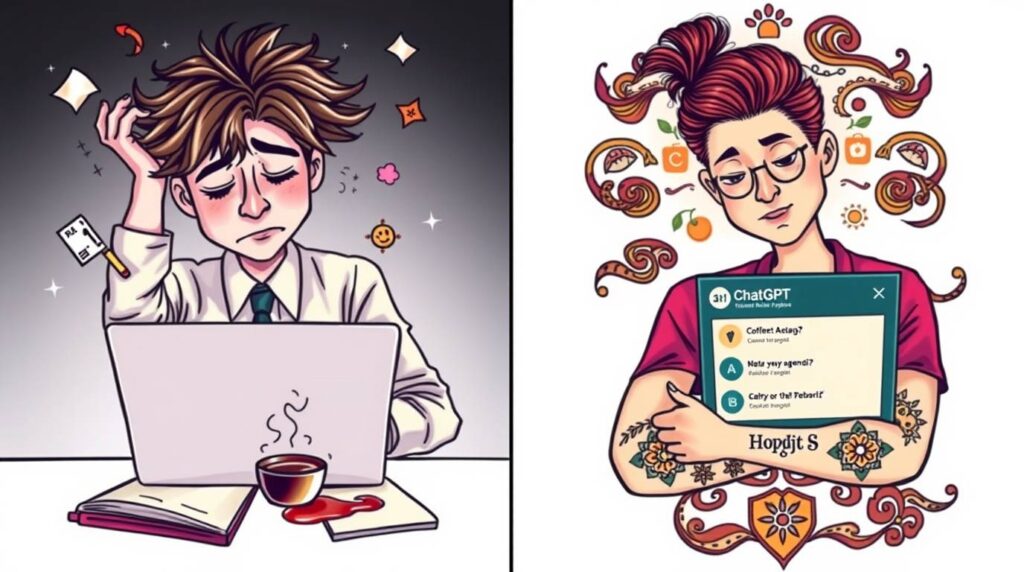You know the feeling. It’s 5:45 AM, coffee hasn’t kicked in, and your calendar notification screams: “Team Sync – 9:00 AM.” Your heart sinks. The meeting you knew was coming… and you completely forgot to draft the agenda. Cue the frantic scramble, jotting down half-formed thoughts, hoping it somehow translates into a productive hour. Sound familiar? You’re not alone. Studies consistently show that poorly planned meetings cost businesses billions annually, with unclear purpose and lack of structure being prime culprits.
But what if I told you that the meeting agenda layout – that critical blueprint for success – could be drafted, structured, and polished in seconds, not hours? Enter ChatGPT. This isn’t about replacing your expertise; it’s about turbocharging it. Let me show you how AI is revolutionizing meeting prep, turning panic into poise.
Why Your Meeting Agenda Layout Isn’t Just Paperwork – It’s the Blueprint
Think of your meeting agenda as the architectural plan for a building. Without it, you’re just throwing bricks together and hoping for a habitable structure. A well-designed meeting agenda layout does far more than list topics:
- Sets Clear Expectations: Everyone knows why they’re there and what needs to be achieved. No more wondering, “What’s this about?”
- Drives Focus: Keeps discussions on track, preventing tangents that eat up valuable time. Research by Atlassian found the average employee attends 62 meetings per month, half deemed unnecessary – a solid agenda combats this.
- Empowers Preparation: Attendees know what they need to review or bring, leading to richer contributions. Imagine walking into a meeting knowing exactly what part requires your input.
- Optimizes Time: Allocating specific durations to each item forces discipline and respects attendees’ calendars. Timeboxing is crucial.
- Creates Accountability: Clearly defined discussion points, owners, and desired outcomes make follow-up actions unambiguous.
The Old Way vs. The AI Way: A Speed and Quality Showdown
Comparison: Traditional vs. AI-Powered Agenda Creation
| Feature | Traditional Method | ChatGPT-Powered Method | Advantage of AI |
| Initial Draft Time | 15-45 minutes | 5-30 seconds | Massive time savings |
| Starting Point | Blank page or outdated template | Instant structured draft | Eliminates “blank page” paralysis |
| Structural Variety | Limited by user’s recall of templates | Dynamically adapts to meeting type | More relevant layouts |
| Idea Generation | Relies solely on user’s knowledge | Suggests relevant topics & questions | Sparks overlooked discussion points |
| Cognitive Load | High (structuring, wording, flow) | Low (focus on editing & refinement) | Reduces mental fatigue |
Mastering the Prompt: Your Key to the Perfect Draft Meeting Agenda Layout
The magic isn’t just in ChatGPT; it’s in how you ask. Vague prompts get vague results. Specificity is your superpower. Here’s how to engineer effective prompts:
- Define the Core Purpose: What’s the one thing this meeting must achieve?
- Weak: “Write an agenda for a team meeting.”
- Strong: “Draft a 45-minute project status meeting agenda focused on identifying roadblocks blocking the Q3 launch deadline for Project Alpha. Goal: Assign clear action owners to resolve each blocker.”
- Specify the Meeting Type: This guides the inherent structure.
- Weak: “Agenda for a meeting.”
- Strong: “Create a meeting agenda layout suitable for a 60-minute brainstorming session aiming to generate at least 10 new feature ideas for our mobile app. Include time for idea grouping and initial prioritization.”
- List Critical Attendees (Optional but Helpful): Helps tailor discussion points.
- Example: “Attendees: Marketing Lead, Product Manager, Lead Developer, UX Designer.”
- Outline Key Topics (If Known): Provide your bullet points; ask ChatGPT to structure them.
- Example: “Structure these topics into a logical 30-minute agenda with time allocations: Q2 Sales Results Review (Sarah), Q3 Pipeline Forecast (Mark), New Lead Gen Tool Demo (Jamie), Action Items.”
- Request Specific Formatting:
- Example: “Format the agenda clearly with sections for: Meeting Goal, Date/Time/Location (Virtual), Attendees, Agenda Items (Topic, Owner, Time, Objective/Desired Outcome), Pre-Work, Parking Lot. Bold the section headers.”
- Iterate and Refine: The first draft is a starting point! Ask ChatGPT to:
- “Shorten the discussion time for Topic X to 5 minutes.”
- “Add a 5-minute buffer at the end.”
- “Rephrase the goal to be more outcome-focused.”
- “Suggest 2-3 key questions to guide the discussion on Topic Y.”
Example Prompt in Action:
“Act as an experienced meeting facilitator. Draft a concise 30-minute weekly team sync meeting agenda layout for a remote software engineering team (8 people). Primary goal: Quickly surface blockers, share key updates (max 1 min each), and confirm priorities for the next 48 hours. Include a strict 5-minute ‘Rapid Blockers’ round-robin, a 10-minute ‘Critical Updates’ section, and a 10-minute ‘Priority Alignment’ discussion. Format clearly with timeboxes for each segment and a section for noting agreed actions. End with a 1-minute positive closing.”
Beyond the Basics: The Essential Elements ChatGPT Gets Right (And You Should Refine)
ChatGPT excels at generating the core structural skeleton of a powerful meeting agenda layout. It naturally incorporates key elements:
- The Non-Negotiable Header: Meeting Title, Date, Time (Start & End!), Location/Virtual Link, Facilitator, Note-taker. ChatGPT will include these if prompted.
- The North Star: Clear Objective/Goal: Not “Discuss Project X,” but “Decide on the final feature scope for Project X MVP.” ChatGPT prompts force you to define this upfront.
- Time-Boxed Agenda Items: Each topic gets a specific, realistic time allocation. ChatGPT helps estimate based on the complexity you describe.
- Designated Owners: Who leads the discussion on each item? This drives accountability. Include it in your prompt (“Assign owners to these topics…”).
- Desired Outcome per Item: What does success look like for this discussion? (e.g., Decision made, Action assigned, Problem clarified, Idea generated). This is CRUCIAL and where your refinement matters most. ChatGPT might suggest outcomes; ensure they are precise.
- Pre-Work/Pre-Reading: What should attendees review before walking in? Saves precious meeting time. Specify in your prompt if needed.
- The Parking Lot: A designated space (on the agenda!) to capture important but off-topic discussions for later. ChatGPT can easily add this section.
- Action Item Capture: A clear section on the agenda to note decisions and next steps (Owner + Deadline) as they happen. Essential!
Essential Meeting Agenda Layout Elements Checklist
- Meeting Title & Goal (Outcome-Focused!)
- Date, Time (Start & End), Location/Link
- Attendees (Required/Optional)
- Facilitator & Note-Taker
- Agenda Items:
- Topic
- Owner (Who leads discussion)
- Time Allocation (Realistic!)
- Objective/Desired Outcome (Most critical!)
- Pre-Work/Pre-Reading
- Parking Lot (For off-topic items)
- Action Items: (To be captured DURING: Decision/Task + Owner + Deadline)
The Tangible Benefits: More Than Just Speed
Using ChatGPT for your meeting agenda layout isn’t just about saving minutes; it unlocks profound benefits:
- Consistency: Ensures every meeting, regardless of who sets it up, starts with a clear, professional structure. This builds good habits across the team.
- Enhanced Clarity & Focus: The act of crafting a good prompt forces you to clarify the meeting’s purpose and desired outcomes before drafting, leading to inherently sharper agendas. The AI then reflects that clarity.
- Reduced Cognitive Load: Offloading the structural mechanics frees your brain to focus on the strategic aspects: the nuances of the discussion points, anticipating challenges, and preparing your own contributions.
- Improved Meeting Culture: When agendas are consistently clear and distributed in advance, it signals respect for attendees’ time and sets the expectation for preparedness and focus. This elevates the entire meeting culture.
- Better Documentation: A well-structured agenda becomes the foundation for effective meeting notes and action item tracking. Everything ties back to the original blueprint.
The Human Touch: Where AI Stops and You Start
Crucially, ChatGPT is your drafting assistant, not your replacement. Its output needs your expertise:
- Strategic Refinement: Does the structure really support the goal? Are the time allocations realistic? Does the flow make sense? You know your team and context best.
- Nuance & Tone: Adjust the language to fit your company culture. Is it too formal? Too casual? Tailor it.
- Contextual Knowledge: ChatGPT doesn’t know the unspoken tensions, recent history, or specific personalities involved. You do. Edit topics or approaches accordingly.
- Accuracy Check: Verify suggestions, especially regarding pre-work links or specific details. AI can hallucinate.
- Ownership: The facilitator (often the agenda creator) owns the meeting’s success. The agenda is a tool, but execution relies on human skill.
Think of it like this: ChatGPT provides the high-quality lumber and blueprint. You are the master carpenter who assembles it, sands the rough edges, and ensures the final structure is sound and fit for purpose.
Conclusion: From Panic to Powerhouse
The meeting agenda layout is too critical to be left to last-minute scrambles or generic templates. It’s the foundation of productive, respectful, and outcome-driven meetings. ChatGPT transforms this foundational task from a time-consuming chore into a near-instantaneous starting point.
By mastering the art of the prompt and applying your essential human judgment and context, you unlock unprecedented efficiency and consistency in your meeting preparation. You move from reactive panic to proactive control. The result? Meetings that start on time, stay on track, achieve their goals, and leave participants feeling their time was truly valued. That’s not just efficiency; that’s a fundamental shift in how we work.
Stop wasting hours agonizing over structure. Start reclaiming your time and elevating your meetings.
Your Turn: Have you tried using ChatGPT or other AI tools for meeting agendas? What was your experience? What’s your biggest meeting pain point? Share your thoughts, tips, or favorite prompts in the comments below! Or better yet – try drafting your next meeting agenda with ChatGPT right now and see the difference seconds can make.
Access ChatGPT –> Click Here!
More Artificial Intelligence Tools –> Click Here!




